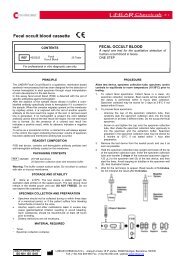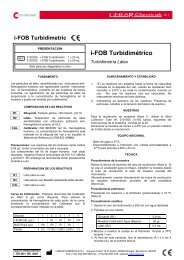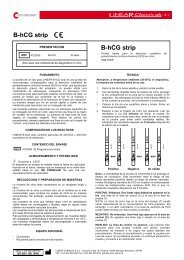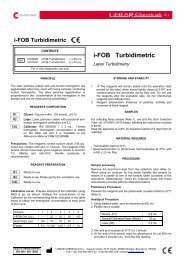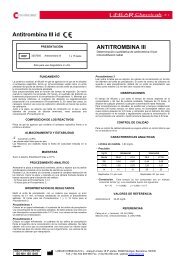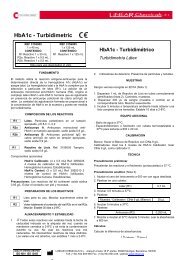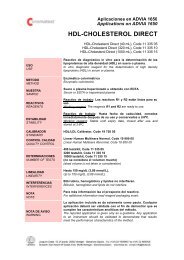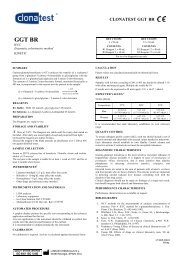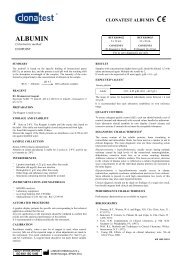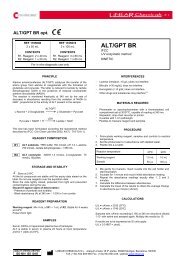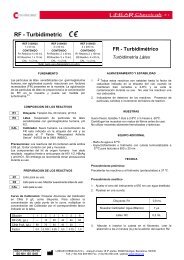FERRITIN- Turbidimetric - LINEAR CHEMICALS
FERRITIN- Turbidimetric - LINEAR CHEMICALS
FERRITIN- Turbidimetric - LINEAR CHEMICALS
You also want an ePaper? Increase the reach of your titles
YUMPU automatically turns print PDFs into web optimized ePapers that Google loves.
CLONATEST <strong>FERRITIN</strong>-<strong>Turbidimetric</strong><br />
<strong>FERRITIN</strong>- <strong>Turbidimetric</strong><br />
Latex Turbidimetry<br />
REF KR31600<br />
REF KR31602<br />
1 x 40 mL 5 x 40 mL<br />
CONTENTS<br />
CONTENTS<br />
R1.Reagent 1 x 32 mL<br />
R1.Reagent 5 x 32 mL<br />
R2.Reagent 1 x 8 mL<br />
R2.Reagent 5 x 8 mL<br />
For in vitro diagnostic use only<br />
SUMMARY<br />
The latex particles coated with anti human ferritin are agglutinated when<br />
they react with samples that contain ferritin. The latex particles<br />
agglutination is proportional to the concentration of the ferritin in the<br />
sample and can be measured by turbidimetry. 1,2<br />
REAGENTS<br />
R1. Diluent. Glycine buffer, 20 mmol/L, pH 8.5.<br />
R2. Latex. Latex particles coated with polyclonal anti-human ferritin<br />
antibodies, pH 8.2.<br />
Precautions: The reagents contain sodium azide 0.95 g/L. Avoid any<br />
contact with skin or mucous.<br />
PREPARATION<br />
R1. Ready to use.<br />
R2. Ready to use. Shake gently the vial before use.<br />
Calibration curve: Use Ferritin Calibrator Set (ref: CT39400). The set<br />
contains 4 different levels of ferritin concentration and it should be used<br />
to prepare the calibration curve. Use ClNa 9 g/L or distilled water as<br />
calibrator 0. For additional information, read Ferritin Calibrator Set Insert.<br />
STORAGE AND STABILITY<br />
1. The reagents will remain stable until the expiration date printed on<br />
the label. For optimal stability store tightly closed at 2-8ºC. Do not<br />
use the reagents after the expiration date.<br />
2. Reagent deterioration: Presence of particles and turbidity.<br />
SAMPLE COLLECTION<br />
Fresh serum. Stable 7 days at 2-8ºC or 3 months at –20ºC.<br />
Samples with presence of fibrin should be centrifuged before testing.<br />
Hemolyzed or contaminated samples are not suitable for testing.<br />
INTERFERENCES<br />
Bilirubin (20 mg/dL), hemoglobin (10 g/L), and rheumatoid factors<br />
(600 IU/mL), do not interfere. Lipemia, interferes. Other substances<br />
may interfere 8 .<br />
ADDITIONAL EQUIPMENT<br />
Analyzer KROMA.<br />
AUTHOMATIC TECHNIQUE<br />
For automatic assays the application method is included.<br />
Any application to an instrument should be validated to demonstrate that<br />
results meet the performance characteristics of the method.<br />
It is recommended to validate periodically the instrument.<br />
CALIBRATION<br />
Recalibrate weekly, when a new lot of reagent is used, when control<br />
recovery falls out of the expected range or when adjustments are made to<br />
the instrument. A reagent blank should be run daily before sample<br />
analysis.<br />
EXPECTED VALUES 3-7<br />
Children: 7 – 140 µg/L<br />
Men: 20 – 250 µg/L<br />
Women: 20 – 200 µg/L<br />
Each laboratory should establish its own reference range.<br />
QUALITY CONTROL<br />
To ensure adequate quality control (QC), each run should include a set of<br />
controls (normal and abnormal) with assayed values handled as unknown.<br />
Each laboratory should establish its own Quality Control scheme and<br />
corrective actions if controls do not meet the acceptable tolerances.<br />
DIAGNOSTIC CHARACTERISTICS 3-7<br />
Ferritin is the major iron storage compound in the body and is considered<br />
one of the most reliable indicators of iron status of patients.<br />
A clinical evaluation of serum ferritin is an index of iron stores.<br />
Whereas low serum concentrations of ferritin are always indicative of an<br />
iron deficiency, elevated concentrations can occur for variety of reasons.<br />
Thus, although elevated concentrations often indicate an excessive iron<br />
intake, they are also caused by liver disease, chronic inflammation and<br />
malignancies.<br />
Pregnant women, blood donors, hemodialysis patients, adolescents and<br />
children are groups particularly at risk. Plasma ferritin is also increased in<br />
patients with hemosiderosis or hemochromatosis.<br />
PERFORMANCE CHARACTERISTICS<br />
Performance characteristics are available on request.<br />
NOTES<br />
1. The linearity limit depends on the sample/reagent ratio, as well as the<br />
analyzer used. It will be higher by decreasing the sample volume,<br />
although the sensitivity of the test will be proportionally decreased.<br />
2. Clinical diagnosis should not be made on findings of a single test<br />
result, but should integrate both clinical and laboratory data.<br />
BIBLIOGRAPHY<br />
1. Newman DJ, Henneberry H, Price CP. Ann Clin Biochem 29: 122-42<br />
(1992).<br />
2. Bernard A, Lauwerys R. J Immunol Methods. 71:141-147 (1984).<br />
3. Wiedermann, Jonetz-Mentzel. Eur J Clin Chem Clin Biochem 31: 453<br />
- 457 (1993).<br />
4. Worwood M. Blood Rewiews. 4 : 259 - 269 (1990).<br />
5. Lipschitz D, Cook JD, Finch CA. The New England J of Med 290:<br />
1213-1216 (1974).<br />
6. Mazza J, Barr RM, McDonald JWD. Can Med Assoc J 119: 884-886<br />
(1978).<br />
7. Tietz Textbook of Clinical Chemistry, 3rd Ed. Burtis CA, Ashwood ER.<br />
WB Saunders Co., (1999).<br />
8. Young DS. Effects of drugs on clinical laboratory tests. 3th ed. AACC<br />
Press (1997).<br />
KR3160-01/1101<br />
QUALITY SYSTEM CERTIFIED<br />
ISO 9001 ISO 13485<br />
<strong>LINEAR</strong> <strong>CHEMICALS</strong> S.L.<br />
08390 Montgat, SPAIN (EU)
CLONATEST <strong>FERRITIN</strong>-<strong>Turbidimetric</strong><br />
<strong>FERRITIN</strong>- <strong>Turbidimetric</strong><br />
Látex Turbidimétrico<br />
REF KR31600<br />
REF KR31602<br />
1 x 40 mL 5 x 40 mL<br />
CONTENIDO<br />
CONTENIDO<br />
R1.Reactivo 1 x 32 mL R1.Reactivo 5 x 32 mL<br />
R2.Reactivo 1 x 8 mL<br />
R2.Reactivo 5 x 8 mL<br />
Sólo para uso diagnóstico in vitro<br />
FUNDAMENTO<br />
Las partículas de látex sensibilizadas con anticuerpos anti-ferritina<br />
humana, son aglutinadas cuando reaccionan con ferritina presente en la<br />
muestra. La aglutinación de las partículas de látex es proporcional a la<br />
concentración de ferritina en la muestra y puede ser medida por<br />
turbidimetría. 1,2<br />
REACTIVOS<br />
R1. Diluyente. Tampón glicina, 20 mmol/L; pH 8,5.<br />
R2. Látex. Suspensión de partículas de látex sensibilizadas con anticuerpo<br />
policlonal anti-ferritina humana, pH 8,2.<br />
Precauciones: Los reactivos del kit contienen azida sódica 0,95 g/L.<br />
Evitar contacto con piel y mucosas.<br />
PREPARATION<br />
R1. Listo para su uso.<br />
R2. Listo para su uso. Mezclar suavemente antes de usar.<br />
Curva de Calibración: Usar Ferritin Calibrator Set (ref: CT39400). El<br />
Set contiene 4 niveles distintos de concentración de ferritina y debe<br />
utilizarse para realizar la curva de calibración. Utilizar ClNa 9 g/L o agua<br />
destilada como calibrador 0. Para mas información, consultar la metódica<br />
del Ferritin Calibrator Set.<br />
ALMACENAMIENTO Y ESTABILIDAD<br />
1. Todos estos reactivos son estables hasta la fecha de caducidad<br />
indicada en la etiqueta del vial. Para una estabilidad optima mantener<br />
los reactivos bien cerrados y conservados a 2-8ºC. No usar los<br />
reactivos una vez caducados.<br />
2. Indicadores de deterioro de los reactivos: Presencia de partículas y<br />
turbidez.<br />
MUESTRAS<br />
Suero fresco. Estable 7 días a 2-8ºC o 3 meses a -20ºC.<br />
Centrifugar las muestras con restos de fibrina antes de usar.<br />
No utilizar muestras altamente hemolizadas o lipémicas.<br />
INTERFERENCIAS<br />
La bilirrubina (20 mg/dL), la hemoglobina (10 g/L) y los factores<br />
reumatoides (600 UI/mL), no interfieren. La lipemia interfiere. Otras<br />
sustancias pueden interferir 8.<br />
EQUIPO ADICIONAL<br />
<br />
Analizador KROMA.<br />
TECNICA AUTOMATICA<br />
Seguir las instrucciones incluidas en la adaptación del analizador.<br />
Cualquier adaptación a un instrumento deberá ser validada con el fin de<br />
demostrar que se cumplen las características analíticas del método.<br />
Se recomienda validar periódicamente el instrumento.<br />
CALIBRACION<br />
Recalibrar semanalmente, al cambiar el lote de reactivos, cuando los<br />
valores del control estén fuera del rango de aceptación o cuando se<br />
realicen ajustes en el instrumento. Se recomienda hacer un blanco del<br />
reactivo cada día de trabajo antes de analizar las muestras.<br />
VALORES DE REFERENCIA 3-7<br />
Niños: 7 - 140 µg/L<br />
Hombres: 20 – 250 µg/L<br />
Mujeres: 20 – 200 µg/L<br />
Es recomendable que cada laboratorio establezca sus propios valores de<br />
referencia.<br />
CONTROL DE CALIDAD<br />
Para un control de calidad adecuado se incluirán en cada serie controles<br />
valorados (normal y patológico) que se tratarán como muestras problema.<br />
Cada laboratorio debería establecer su propio Control de Calidad y<br />
establecer correcciones en el caso que los controles no cumplan con las<br />
tolerancias exigidas.<br />
SIGNIFICADO CLINICO 3-7<br />
La ferritina es el mayor componente procedente de las reservas de hierro<br />
del organismo y se considera como uno de los mejores indicadores del<br />
estadio de hierro en los pacientes.<br />
Mientras que concentraciones bajas de ferritina son siempre indicadoras<br />
de deficiencia de hierro, concentraciones elevadas pueden ser debidas a<br />
diversas causas y orígenes. Aunque una elevada concentración a menudo<br />
es debida a un exceso de aporte de hierro, también puede ser causada por<br />
un trastorno hepático, inflamaciones crónicas y neoplasias. La ferritina<br />
plasmática también puede incrementarse como consecuencia de la<br />
hemosiderosis o hemocromatosis.<br />
Las mujeres embarazadas, donantes de sangre, pacientes con hemodiálisis,<br />
adolescentes y niños, son especialmente grupos de riesgo. La<br />
concentración de ferritina puede ser baja en algunos casos casos.<br />
CARACTERISTICAS ANALITICAS<br />
Las características analíticas están disponibles bajo solicitud.<br />
NOTAS<br />
1. La linealidad del ensayo depende de la relación muestra/reactivo y<br />
analizador utilizado. Disminuyendo el volumen de muestra, se aumenta el<br />
límite superior de linealidad, aunque se reduce la sensibilidad.<br />
2. El diagnóstico clínico no debe realizarse únicamente con los resultados<br />
de un único ensayo, sino que debe considerarse al mismo tiempo los<br />
datos clínicos del paciente.<br />
REFERENCIAS<br />
1. Newman DJ, Henneberry H, Price CP. Ann Clin Biochem 29: 122-42<br />
(1992).<br />
2. Bernard A, Lauwerys R. J Immunol Methods. 71:141-147 (1984).<br />
3. Wiedermann, Jonetz-Mentzel. Eur J Clin Chem Clin Biochem 31: 453 -<br />
457 (1993).<br />
4. Worwood M. Blood Rewiews. 4 : 259 - 269 (1990).<br />
5. Lipschitz D, Cook JD, Finch CA. The New England J of Med 290:<br />
1213-1216 (1974).<br />
6. Mazza J, Barr RM, McDonald JWD. Can Med Assoc J 119: 884-886<br />
(1978).<br />
7. Tietz Textbook of Clinical Chemistry, 3rd Ed. Burtis CA, Ashwood ER.<br />
WB Saunders Co., (1999).<br />
8. Young DS. Effects of drugs on clinical laboratory tests. 3th ed. AACC<br />
Press (1997).<br />
QUALITY SYSTEM CERTIFIED<br />
ISO 9001 ISO 13485<br />
<strong>LINEAR</strong> <strong>CHEMICALS</strong> S.L.<br />
08390 Montgat, SPAIN (EU)
Aplicaciones en KROMA<br />
Applications on KROMA<br />
Ferritin-TURBIDIMETRIC<br />
Two reagents method<br />
Ferritin -<strong>Turbidimetric</strong> (1 x 40 mL), Code KR31600<br />
Ferritin -<strong>Turbidimetric</strong> (5 x 40 mL), Code KR31602<br />
USO<br />
USE<br />
METODO<br />
METHOD<br />
MUESTRA<br />
SAMPLE<br />
REACTIVOS<br />
REAGENTS<br />
CALIBRACION<br />
CALIBRATION<br />
CALIBRADOR<br />
STANDARD<br />
CONTROL CALIDAD<br />
QUALITY CONTROL<br />
DETERMINACIONES<br />
NUMBER OF TESTS<br />
LINEALIDAD<br />
<strong>LINEAR</strong>ITY<br />
EFECTO PROZONA<br />
PROZONE EFFECT<br />
NOTA<br />
NOTE<br />
NOTA DE AVISO<br />
WARNING<br />
Reactivo de diagnóstico in vitro para la cuantificación de la ferritina<br />
humana en suero o plasma.<br />
In vitro diagnostic reagent for the measurement of the human ferritin in<br />
serum or plasma.<br />
Turbidimetría.<br />
Turbidimetry.<br />
Suero o plasma recogido en EDTA.<br />
Serum or EDTA plasma.<br />
Reactivo 1: Usar el Diluyente; Reactivo 2: Usar el Látex.<br />
Reagent 1: Use the Diluent; Reagent 2: Use the Latex.<br />
Curva de calibración<br />
Calibration curve<br />
Linear <strong>FERRITIN</strong>-TURBIDIMETRIC-CALIBRATOR Code 3940005<br />
Ferritin Calibrator set CT39400<br />
Linear Plasma Protein Control N-I Code 3915010<br />
Linear Plasma Protein Control N-II Code 3915015<br />
200 tests/kit Code KR31600<br />
1000 tests/kit Code KR31602<br />
(no se considera el volumen muerto).<br />
(dead volume is not taken in consideration).<br />
Sin post-dilución automática: 3 – 300 ng/mL<br />
Without automatic post-dilution: 3 – 300 ng/mL<br />
Hasta 4000 ng/mL<br />
Up to 4000 ng/mL<br />
Para más información lea el prospecto del reactivo.<br />
For additional information read reagent packaging insert.<br />
La aplicación incluida se da solamente como pauta. Cualquier<br />
aplicación deberá ser validad con el fin de demostrar que se cumplen<br />
las características analíticas del método.<br />
The reported application is given only as a guideline. Any application to an<br />
instrument should be validated to demonstrate that results meet the<br />
performance characteristics of the method.<br />
QUALITY SYSTEM CERTIFIED<br />
ISO 9001 ISO 13485<br />
<strong>LINEAR</strong> <strong>CHEMICALS</strong> S.L.<br />
08390 Montgat, SPAIN (EU)
KROMA<br />
<strong>FERRITIN</strong>-TURBIDIMETRIC<br />
Name N. of Standards N. of rep. Units Stability<br />
Ferritin-<strong>Turbidimetric</strong> 5 1 ng/mL<br />
*<br />
* entered by the user KR31600-02-1/0907<br />
QUALITY SYSTEM CERTIFIED<br />
ISO 9001 ISO 13485<br />
<strong>LINEAR</strong> <strong>CHEMICALS</strong> S.L.<br />
08390 Montgat, SPAIN (EU)



